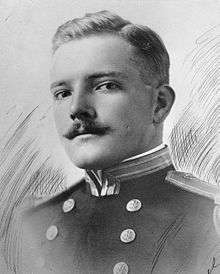William M. Corry Jr.
| William Merrill Corry Jr. | |
|---|---|
 William Merrill Corry Jr., USN (1889-1920) | |
| Born |
October 5, 1889 Quincy, Florida |
| Died |
October 6, 1920 (aged 31) Hartford, Connecticut |
| Place of burial | Eastern Cemetery Quincy Florida |
| Allegiance |
|
| Service/branch | United States Navy |
| Years of service | 1910 - 1920 |
| Rank | Lieutenant Commander |
| Unit | USS Pennsylvania |
| Battles/wars | World War I |
| Awards | Medal of Honor |
William Merrill Corry Jr. (October 5, 1889 – October 6, 1920) was a Lieutenant-Commander in the United States Navy during World War I and a recipient of the Medal of Honor.
Biography
Corry was born at Quincy, Florida. Admitted to the Naval Academy in June 1906, he graduated in 1910 and spent the next five years serving in the battleship USS Kansas. In mid-1915, Lieutenant (Junior Grade) Corry began instruction in aviation at Pensacola, Florida, and was designated Naval Aviator #23 in March 1916. He had flying positions with the armored cruiser USS Washington between November 1916 and May 1917, then was an officer on the armored cruiser USS North Carolina.
In August 1917, Lieutenant Corry began World War I service in France, where he commanded Naval Air Stations at Le Croisic and Brest during 1918 and early 1919. He was promoted to Lieutenant Commander in July 1918. Corry remained in France for the rest of 1919 and the first half of 1920, involved in removing U.S. Naval Aviation forces from Europe as part of the post-war demobilization.
In mid-1920, Lieutenant Commander Corry was assigned as aviation aide to the Commander-in-Chief, Atlantic Fleet, stationed on the Fleet's flagship, USS Pennsylvania. In early October 1920, while on a flight from Long Island, New York, with another pilot, the plane crashed near Hartford, Connecticut. Though thrown clear of the wreckage, the injured Corry ran back to pull the other officer free of the flaming aircraft. Badly burned during this rescue, William M. Corry died at Hartford on October 6, 1920. He posthumously received the Medal of Honor for his heroism during that accident.
He is buried in Eastern Cemetery, Quincy, Florida.[1]
Namesake
Airfields at Pensacola, Florida (now Naval Air Station Pensacola, Center for Information Dominance Corry Station - and Naval Information Operations Command Pensacola tenant command), and three ships have been named USS Corry in his honor.
Medal of Honor citation
Rank and organization: Lieutenant Commander, U.S. Navy. Place and date: Near Hartford, Conn., October 2, 1920. Born: October 5, 1889, Quincy, Fla. Accredited to: Florida. Other Navy award: Navy Cross.
Citation:
For heroic service in attempting to rescue a brother officer from a flame-enveloped airplane. On 2 October 1920, an airplane in which Lt. Comdr. Corry was a passenger crashed and burst into flames. He was thrown 30 feet clear of the plane and, though injured, rushed back to the burning machine and endeavored to release the pilot. In so doing he sustained serious burns, from which he died 4 days later.[2]
See also
Notes
- ↑ "William M. Corry Jr.". Claim to Fame: Medal of Honor recipients. Find a Grave. Retrieved October 11, 2007.
- ↑ "William M. Corry Jr., Medal of Honor recipient". Interim 1920-1940. United States Army Center of Military History. June 8, 2009. Retrieved November 27, 2007.
Attribution
 This article incorporates public domain material from websites or documents of the Naval History & Heritage Command.
This article incorporates public domain material from websites or documents of the Naval History & Heritage Command.
External links
| Wikimedia Commons has media related to William M. Corry Jr.. |
- "Lieutenant Commander William M. Corry Jr., USN (1889-1920)". Naval History & Heritage Command, Department of the Navy. January 18, 2004.
- "William M. Corry Jr., Medal of Honor recipient". Interim 1920-1940. United States Army Center of Military History. June 8, 2009. Retrieved November 27, 2007.
- "William M. Corry Jr.". Claim to Fame: Medal of Honor recipients. Find a Grave. Retrieved October 11, 2007.